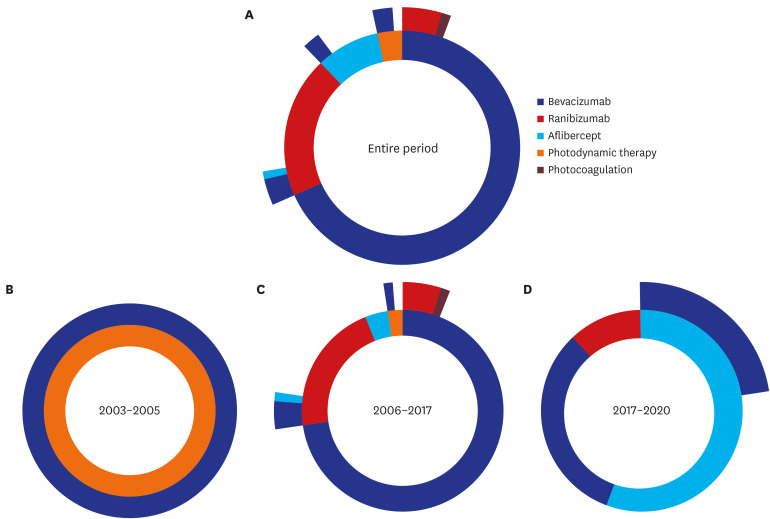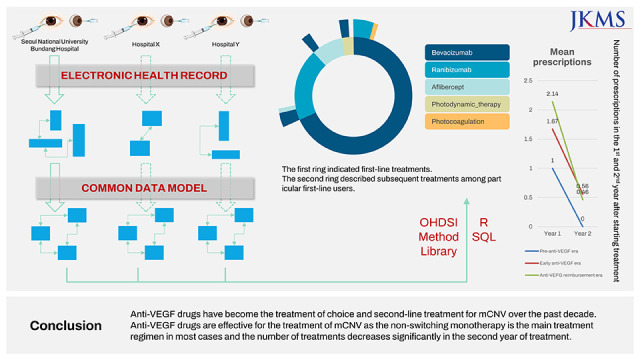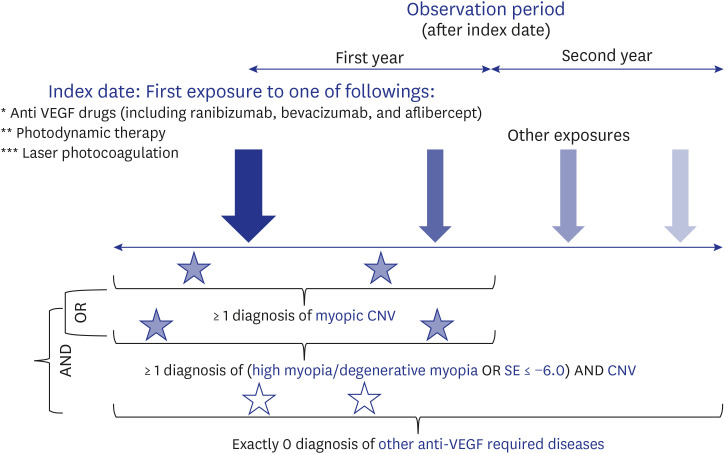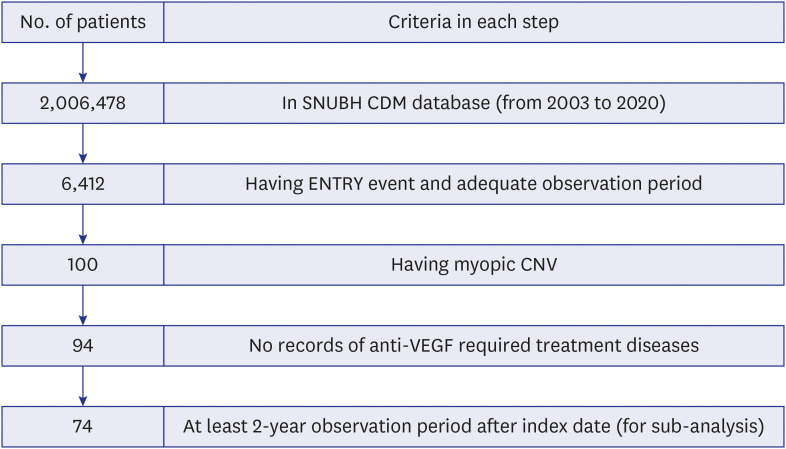1. Pan CW, Ramamurthy D, Saw SM. Worldwide prevalence and risk factors for myopia. Ophthalmic Physiol Opt. 2012; 32(1):3–16. PMID:
22150586.

2. Rim TH, Kim SH, Lim KH, Choi M, Kim HY, Baek SH, et al. Refractive errors in Koreans: the Korea National Health and Nutrition Examination Survey 2008–2012. Korean J Ophthalmol. 2016; 30(3):214–224. PMID:
27247521.

3. Kuehn BM. Increase in myopia reported among children during COVID-19 Lockdown. JAMA. 2021; 326(11):999.

4. Ma M, Xiong S, Zhao S, Zheng Z, Sun T, Li C. COVID-19 home quarantine accelerated the progression of myopia in children aged 7 to 12 years in China. Invest Ophthalmol Vis Sci. 2021; 62(10):37.

5. Neelam K, Cheung CM, Ohno-Matsui K, Lai TY, Wong TY. Choroidal neovascularization in pathological myopia. Prog Retin Eye Res. 2012; 31(5):495–525. PMID:
22569156.

6. Ang M, Wong TY. Updates on Myopia: A Clinical Perspective. Singapore, Singapore: Springer Nature;2020.
7. Toto L, Di Antonio L, Costantino O, Mastropasqua R. Anti-VEGF therapy in myopic CNV. Curr Drug Targets. 2021; 22(9):1054–1063. PMID:
33511955.

8. Cohen SY, Laroche A, Leguen Y, Soubrane G, Coscas GJ. Etiology of choroidal neovascularization in young patients. Ophthalmology. 1996; 103(8):1241–1244. PMID:
8764794.

9. Miller DG, Singerman LJ. Vision loss in younger patients: a review of choroidal neovascularization. Optom Vis Sci. 2006; 83(5):316–325. PMID:
16699445.

10. Stuart A, Ford JA, Duckworth S, Jones C, Pereira A. Anti-VEGF therapies in the treatment of choroidal neovascularisation secondary to non-age-related macular degeneration: a systematic review. BMJ Open. 2015; 5(4):e007746.

11. Cohen SY. Anti-VEGF drugs as the 2009 first-line therapy for choroidal neovascularization in pathologic myopia. Retina. 2009; 29(8):1062–1066. PMID:
19734760.

12. Wolf S, Balciuniene VJ, Laganovska G, Menchini U, Ohno-Matsui K, Sharma T, et al. RADIANCE: a randomized controlled study of ranibizumab in patients with choroidal neovascularization secondary to pathologic myopia. Ophthalmology. 2014; 121(3):682–92.e2. PMID:
24326106.

13. Ikuno Y, Ohno-Matsui K, Wong TY, Korobelnik JF, Vitti R, Li T, et al. Intravitreal aflibercept injection in patients with myopic choroidal neovascularization: the MYRROR study. Ophthalmology. 2015; 122(6):1220–1227. PMID:
25745875.

14. Willis J, Morse L, Vitale S, Parke DW 2nd, Rich WL, Lum F, et al. Treatment patterns for myopic choroidal neovascularization in the United States: analysis of the IRIS registry. Ophthalmology. 2017; 124(7):935–943. PMID:
28372860.

15. Yang MC, Chen YP, Tan EC, Leteneux C, Chang E, Chu CH, et al. Epidemiology, treatment pattern and health care utilization of myopic choroidal neovascularization: a population based study. Jpn J Ophthalmol. 2017; 61(2):159–168. PMID:
28062929.

16. Ohno-Matsui K, Suzaki M, Teshima R, Okami N. Real-world data on ranibizumab for myopic choroidal neovascularization due to pathologic myopia: results from a post-marketing surveillance in Japan. Eye (Lond). 2018; 32(12):1871–1878. PMID:
30158574.

17. Wecker T, Ehlken C, Bühler A, Lange C, Agostini H, Böhringer D, et al. Five-year visual acuity outcomes and injection patterns in patients with pro-re-nata treatments for AMD, DME, RVO and myopic CNV. Br J Ophthalmol. 2017; 101(3):353–359. PMID:
27215744.

18. Wu TT, Kung YH. Two-year outcome of intravitreal injections of ranibizumab for myopic choroidal neovascularization. J Ocul Pharmacol Ther. 2014; 30(10):837–841. PMID:
25162313.

19. Park SJ, Kwon KE, Choi NK, Park KH, Woo SJ. Prevalence and incidence of exudative age-related macular degeneration in South Korea: a nationwide population-based study. Ophthalmology. 2015; 122(10):2063–70.e1. PMID:
26208437.

20. Hripcsak G, Duke JD, Shah NH, Reich CG, Huser V, Schuemie MJ, et al. Observational Health Data Sciences and Informatics (OHDSI): opportunities for observational researchers. Stud Health Technol Inform. 2015; 216:574–578. PMID:
26262116.
21. Lee KA, Jin HY, Kim YJ, Im YJ, Kim EY, Park TS. Treatment patterns of type 2 diabetes assessed using a common data model based on electronic health records of 2000–2019. J Korean Med Sci. 2021; 36(36):e230. PMID:
34519186.

22. Mun Y, You SC, Lee DY, Kim S, Chung YR, Lee K, et al. Real-world incidence of endopthalmitis after intravitreal anti-VEGF injections in Korea: findings from the Common Data Model in ophthalmology. Epidemiol Health. 2021; 43:e2021097. PMID:
34773936.

23. Mun Y, Park C, Lee DY, Kim TM, Jin KW, Kim S, et al. Real-world treatment intensities and pathways of macular edema following retinal vein occlusion in Korea from Common Data Model in ophthalmology. Sci Rep. 2022; 12(1):10162. PMID:
35715561.

24. Kang DY, Kim H, Ko S, Kim H, Shinn J, Kang MG, et al. Sodium-glucose cotransporter-2 inhibitor-related diabetic ketoacidosis: accuracy verification of operational definition. J Korean Med Sci. 2022; 37(7):e53. PMID:
35191230.

25. Ohno-Matsui K, Ikuno Y, Lai TY, Gemmy Cheung CM. Diagnosis and treatment guideline for myopic choroidal neovascularization due to pathologic myopia. Prog Retin Eye Res. 2018; 63:92–106. PMID:
29111299.

26. Tah V, Orlans HO, Hyer J, Casswell E, Din N, Sri Shanmuganathan V, et al. Anti-VEGF therapy and the retina: an update. J Ophthalmol. 2015; 2015:627674. PMID:
26417453.

27. Wakabayashi T, Ikuno Y, Gomi F, Hamasaki T, Tano Y. Intravitreal bevacizumab vs sub-tenon triamcinolone acetonide for choroidal neovascularization attributable to pathologic myopia. Am J Ophthalmol. 2009; 148(4):591–596.e1. PMID:
19589497.

28. Karasu B, Celebi AR. The efficacy of different anti-vascular endothelial growth factor agents and prognostic biomarkers in monitoring of the treatment for myopic choroidal neovascularization. Int Ophthalmol. 2022; 42(9):2729–2740. PMID:
35357641.

29. Mallone F, Giustolisi R, Franzone F, Marenco M, Plateroti R, Nebbioso M, et al. Ten-year outcomes of intravitreal bevacizumab for myopic choroidal neovascularization: analysis of prognostic factors. Pharmaceuticals (Basel). 2021; 14(10):1042. PMID:
34681267.

30. Hamilton RD, Clemens A, Minnella AM, Lai TY, Dai H, Sakamoto T, et al. Real-world effectiveness and safety of ranibizumab for the treatment of myopic choroidal neovascularization: Results from the LUMINOUS study. PLoS One. 2020; 15(1):e0227557. PMID:
31961888.

31. Tan NW, Ohno-Matsui K, Koh HJ, Nagai Y, Pedros M, Freitas RL, et al. Long-term outcomes of ranibizumab treatment of myopic choroidal neovascularization in East-Asian patients from the RADIANCE study. Retina. 2018; 38(11):2228–2238. PMID:
28961671.

32. Chen Y, Sharma T, Li X, Song Y, Chang Q, Lin R, et al. Ranibizumab versus verteporfin photodynamic therapy in Asian patients with myopic choroidal neovascularization: BRILLIANCE, a 12-month, randomized, double-masked study. Retina. 2019; 39(10):1985–1994. PMID:
30204730.

33. Schmidt-Erfurth U, Chong V, Loewenstein A, Larsen M, Souied E, Schlingemann R, et al. Guidelines for the management of neovascular age-related macular degeneration by the European Society of Retina Specialists (EURETINA). Br J Ophthalmol. 2014; 98(9):1144–1167. PMID:
25136079.

34. Amoaku WM, Ghanchi F, Bailey C, Banerjee S, Banerjee S, Downey L, et al. Diabetic retinopathy and diabetic macular oedema pathways and management: UK Consensus Working Group. Eye (Lond). 2020; 34(Suppl 1):1–51.

35. Erden B, Bölükbaşı S, Baş E, Çakır A. Comparison of intravitreal aflibercept and ranibizumab for treatment of myopic choroidal neovascularization: one-year results-a retrospective, comparative study. J Ophthalmol. 2019; 2019:8639243. PMID:
32082619.

36. Wang JK, Huang TL, Chang PY, Chen YT, Chang CW, Chen FT, et al. Intravitreal aflibercept versus bevacizumab for treatment of myopic choroidal neovascularization. Sci Rep. 2018; 8(1):14389. PMID:
30258077.

37. Wu B, Wu H, Liu X, Lin H, Li J. Ranibizumab versus bevacizumab for ophthalmic diseases related to neovascularisation: a meta-analysis of randomised controlled trials. PLoS One. 2014; 9(7):e101253. PMID:
24983855.

38. Munk MR, Rückert R, Zinkernagel M, Ebneter A, Wolf S. The role of anti-VEGF agents in myopic choroidal neovascularization: current standards and future outlook. Expert Opin Biol Ther. 2016; 16(4):477–487. PMID:
26666589.

39. Amoaku WM, Chakravarthy U, Gale R, Gavin M, Ghanchi F, Gibson J, et al. Defining response to anti-VEGF therapies in neovascular AMD. Eye (Lond). 2015; 29(6):721–731. PMID:
25882328.

40. Yang HS, Kim JG, Kim JT, Joe SG. Prognostic factors of eyes with naïve subfoveal myopic choroidal neovascularization after intravitreal bevacizumab. Am J Ophthalmol. 2013; 156(6):1201–1210.e2. PMID:
24075429.








 PDF
PDF Citation
Citation Print
Print






 XML Download
XML Download